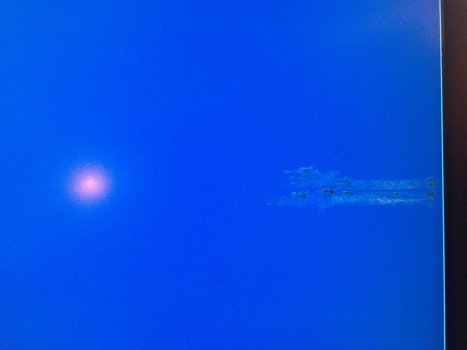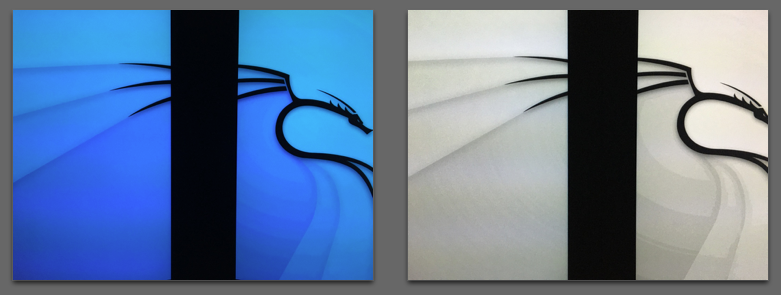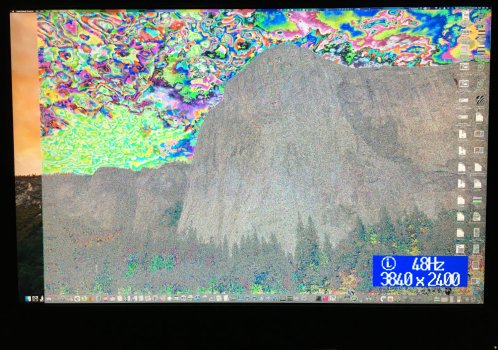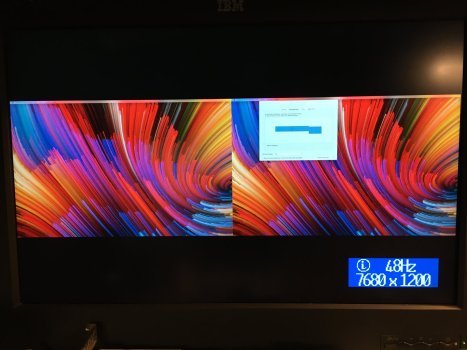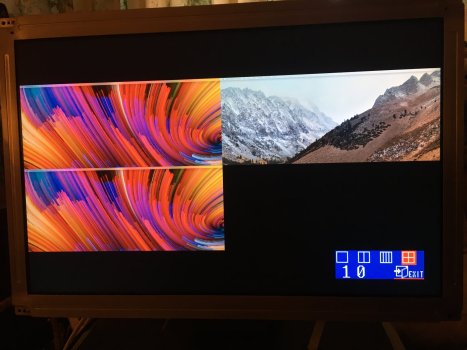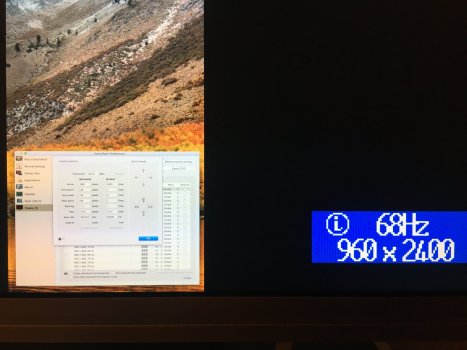Hello all,
This is kind of an obscure advice-needed/infodump post, though for me this is all just tinkering or proof-of-concept.
I have a cMP 4,1->5,1 with an MVC-flashed 1080Ti as its GPU, as such it's still running 10.13.6 with nVidia's web drivers (this works fine.)
Recently I've been experimenting with IBM T221 displays (9503-DGM & 9503-DGP) ultimately with the goal of getting them running at native resolution/refresh over one modern high bandwidth link, recognized as a single display by macOS. HDMI 2.0 and DP 1.4a on the 1080Ti should each be up to the task.
It seems doable in theory using one of two schemes:
• 2x LFH60 - DVI-DL adapters and 2x active DP -> DVI-DL adapters (Accell B087B-002B in my case) should be possible to use two custom EDIDs with Tiling info, then perhaps a StarTech MST miniDP -> 2x DP would work properly (tiled instead of mirrored) in macOS. Unfortunately the two LFH-60 to DVI-DL adapters I have did not come with the period addon EDID chip modules, so I'll need to create these if I want to pursue this route. For now this is left on the shelf... (Very helpfully, Jack Doerner has already adapted two 48Hz tiled EDIDs for the T221 and left them available here: https://jackdoerner.net/exposition/2017/05/IBM_T221_Linux/ This scheme also allows for a panel overclock of 55Hz+)
• 3x DVI-SL using the undocumented 3x 1280x2400 stripe scheme available on 9503-DG5/DGM/DGP models. This is fundamentally not too different from the factory 2624x2400 DVI-DL + 1216x2400 DVI-SL scheme listed in the manual, but since this does allow three identical signals it becomes possible to bodge in a Matrox TripleHead2Go. This solves the problem of treating the three signals as one display since Matrox boxes already appear this way to the system.
(http://stormdecay.com:1984/displays_ibm_bertha.html#manualmodes)
I've left a ton of Bertha related notes on this page as I tested various Matrox devices, but the TL;DR is the TripleHead2Go Digital SE is better suited to this task than either the Digital Edition or the DP Edition, so all the references to TH2G in this post will refer to the Digital SE (DP input; 3x DVI outputs.)
The TH2G first needs to be set using Matrox PowerDesk to the 3x 1280 x 1024 scheme, then a tool such as SwitchResX can be used to send any custom 3840 x **** resolution which will be properly interpreted by the T221. As long as the horizontal resolution is 3840 and the vertical resolution exceeds 1200 lines the TH2G will be happy and the T221 will use stripe mode instead of tile mode.
(https://forums.macrumors.com/thread...indows-computers-via-dp.2227756/post-29744900)
@Amethyst1 posted here about overclocking the individual DVI link signal to over 172MHz in order to achieve 46.7 Hz /1280 x 2400, but in my testing it seems there is even better news because the T221 supports extremely tight blanking intervals even behind the TH2G. Using horizontal front porch: 48, sync: 32, back: 56; vertical front porch: 1, sync: 2, back: 1 produces a stable image and allows even 165.00MHz to exceed 48Hz at 1280 x 2400. Additionally, my T221s seem to accept signals up to 176.64 MHz at 1280 x 2400 if the H back porch is upped to 62px which theoretically produces a full panel sync within the range of an overclocked panel (direct sync range is 38.24 Hz - 48.76 Hz for stock [as tested]; 49.6 Hz - 63.0 Hz for overclocked according to cirthix.)
Here's where I start running into trouble. SwitchResX indicates the maximum pixel clock of the TripleHead2Go is 358.20 MHz. This doesn't seem unreasonable except that when I plug in a 4K HDMI -> DP adapter which appears with a 600 MHz maximum pixel clock, both the TH2G and T221 cooperate perfectly up to roughly 452.24 MHz (annoyingly close to native - 47.314 Hz at 3840 x 2400 - 48, 32, 56; 1, 2, 1.) FWIW the same TH2G plugged into a 2015 MacBook Pro shows a total pixel clock limit of 365.00 MHz - presumably that's the laptop's limit and not the TH2G's, but frustrating that the 1080Ti with web drivers won't even match this limit.
The HDMI solution is great but very imperfect for a few reasons.
1. There seems to be subtle color banding present which stands out in especially dark gradients. I've followed the guide below but unfortunately noticed no change. It seems the HDMI signal is already being interpreted in RGB 4:4:4 but the DP output of the HDMI adapter is still somewhat crushed compared to direct DP-DP on the TH2G. Fortunately all text is sharp and no fringing is visible on interpolated patterns.
Fixing the External Monitor Color Problem with Your 2018 MacBook Pro (atomicobject.com)
2. The signal desyncs periodically. It tends to work perfectly for minutes to hours on end, but will occasionally send the T221 repeatedly to flashing black screen for up to a minute before becoming stable again. I attribute this only to the HDMI adapter because it also does this when running other 'standard' DP displays - and the TH2G has a sync LED which also flashes on and off while the T221 is attempting to resync. No such instability is noted when using DP-DP signal with the same blanking intervals at 3x1280x2400.
3. The 1080Ti has only one HDMI port and I'd like to run two or three T221s within the native sync range if possible (lol)
Beyond this, I also observe that despite graphical distortion quickly overcoming the image beyond 452.24 MHz, the T221 seems to present a stable unified image well beyond this point. Even true 48 Hz at ~460MHz can be identified as one stable image with uniform distortion on the left edge - as though the HDMI adapter is introducing the garbled image and the TH2G is still perfectly stable across the three links. The T221's OSD reads 48 Hz as this happens. I'm hoping that without the HDMI adapter it may be possible to run the TH2G at true 48 Hz cleanly. It really seems like the TH2G should be able to negotiate a direct DP link with the 1080Ti beyond 358.20 MHz.
I did find and install Floris497's mac-pixel-clock-patch-V2 (both CoreDisplay Patcher v4 and nVidia Web Pascal patcher v1 - thanks @joevt for leaving some helpful breadcrumbs about how to install this successfully on 10.13) and I was able to verify the 165.00 MHz limit in SwitchResX was lifted to 800.00 MHz on the HDMI port when plugged into a standard DVI 1920x1200 display. Unfortunately the DP connections still showed a limit of 358.20 MHz when connected to the TH2G (also the two DH2G Digital SEs I have currently running a second T221 as two logical displays.)
As a last effort I installed Lilu and WhateverGreen (verified active in IORegistryExplorer; I had no other symptoms to resolve) and this seemed to change the DP behavior to display a 600 MHz limit, but SwitchResX still shows 'Not active- invalid?' for all resolutions above 358.20 MHz. Hitting 'activate immediately' briefly shows a maximum pixel clock of 358.20 MHz before a moment later it changes to 600.00 MHz - still only activating the lower pixel clock resolutions.
Is there anything else I should try? Could it be that whatever compression the HDMI adapter is using to create the banding actually fits the 47.314 Hz signal into a total pixel clock lower than 452.24 MHz at the DP signal's end?
I'm still on MP51.0089.B00 because I've never entertained Mojave (nVidia, and my Amfeltec SSD RAID is comprised of SM951 AHCI blades.) I could try updating to 144.0.0.0.0 if it would provide any benefit on High Sierra. I'm also not using OpenCore, but I could also try that if it would help.
I'll be curious to see what other ideas or suggestions y'all have on this. I've come so close, yet still so far...
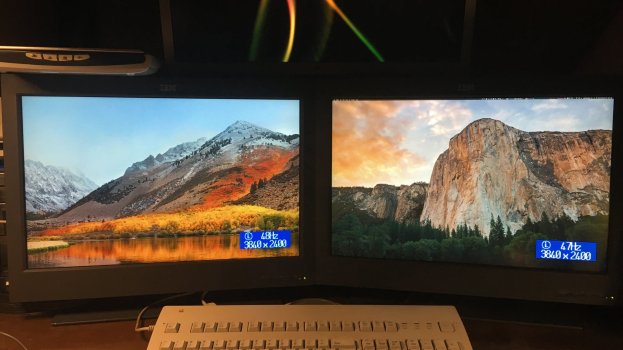
(right monitor using aforementioned HDMI -> TH2G; left monitor is logically two DH2G 3840 x 1200 displays stacked, e.g. cheating by turning off 'Displays have separate Spaces' and editing two versions of the desktop picture. Dragged windows still like to snap away from the center and some content can't render across the whole desktop. Eventually I'll swap the DH2Gs for the MST tiled idea and try overclocking that panel for 55-60Hz operation. In the meantime the DH2Gs seem to avoid tearing more reliably than the two LFH60-DVI-DL scheme for some reason. Even windowed youtube videos seem smooth this way, but tear noticeably with the two Accell boxes. I imagine in MST tile mode they'll be genlocked to resolve this.)
P.S. unfortunately the eBay item for the HDMI-DP adapter has been removed, but here's a screenshot of the listing in case it's of any use.

This is kind of an obscure advice-needed/infodump post, though for me this is all just tinkering or proof-of-concept.
I have a cMP 4,1->5,1 with an MVC-flashed 1080Ti as its GPU, as such it's still running 10.13.6 with nVidia's web drivers (this works fine.)
Recently I've been experimenting with IBM T221 displays (9503-DGM & 9503-DGP) ultimately with the goal of getting them running at native resolution/refresh over one modern high bandwidth link, recognized as a single display by macOS. HDMI 2.0 and DP 1.4a on the 1080Ti should each be up to the task.
It seems doable in theory using one of two schemes:
• 2x LFH60 - DVI-DL adapters and 2x active DP -> DVI-DL adapters (Accell B087B-002B in my case) should be possible to use two custom EDIDs with Tiling info, then perhaps a StarTech MST miniDP -> 2x DP would work properly (tiled instead of mirrored) in macOS. Unfortunately the two LFH-60 to DVI-DL adapters I have did not come with the period addon EDID chip modules, so I'll need to create these if I want to pursue this route. For now this is left on the shelf... (Very helpfully, Jack Doerner has already adapted two 48Hz tiled EDIDs for the T221 and left them available here: https://jackdoerner.net/exposition/2017/05/IBM_T221_Linux/ This scheme also allows for a panel overclock of 55Hz+)
• 3x DVI-SL using the undocumented 3x 1280x2400 stripe scheme available on 9503-DG5/DGM/DGP models. This is fundamentally not too different from the factory 2624x2400 DVI-DL + 1216x2400 DVI-SL scheme listed in the manual, but since this does allow three identical signals it becomes possible to bodge in a Matrox TripleHead2Go. This solves the problem of treating the three signals as one display since Matrox boxes already appear this way to the system.
(http://stormdecay.com:1984/displays_ibm_bertha.html#manualmodes)
I've left a ton of Bertha related notes on this page as I tested various Matrox devices, but the TL;DR is the TripleHead2Go Digital SE is better suited to this task than either the Digital Edition or the DP Edition, so all the references to TH2G in this post will refer to the Digital SE (DP input; 3x DVI outputs.)
The TH2G first needs to be set using Matrox PowerDesk to the 3x 1280 x 1024 scheme, then a tool such as SwitchResX can be used to send any custom 3840 x **** resolution which will be properly interpreted by the T221. As long as the horizontal resolution is 3840 and the vertical resolution exceeds 1200 lines the TH2G will be happy and the T221 will use stripe mode instead of tile mode.
(https://forums.macrumors.com/thread...indows-computers-via-dp.2227756/post-29744900)
@Amethyst1 posted here about overclocking the individual DVI link signal to over 172MHz in order to achieve 46.7 Hz /1280 x 2400, but in my testing it seems there is even better news because the T221 supports extremely tight blanking intervals even behind the TH2G. Using horizontal front porch: 48, sync: 32, back: 56; vertical front porch: 1, sync: 2, back: 1 produces a stable image and allows even 165.00MHz to exceed 48Hz at 1280 x 2400. Additionally, my T221s seem to accept signals up to 176.64 MHz at 1280 x 2400 if the H back porch is upped to 62px which theoretically produces a full panel sync within the range of an overclocked panel (direct sync range is 38.24 Hz - 48.76 Hz for stock [as tested]; 49.6 Hz - 63.0 Hz for overclocked according to cirthix.)
Here's where I start running into trouble. SwitchResX indicates the maximum pixel clock of the TripleHead2Go is 358.20 MHz. This doesn't seem unreasonable except that when I plug in a 4K HDMI -> DP adapter which appears with a 600 MHz maximum pixel clock, both the TH2G and T221 cooperate perfectly up to roughly 452.24 MHz (annoyingly close to native - 47.314 Hz at 3840 x 2400 - 48, 32, 56; 1, 2, 1.) FWIW the same TH2G plugged into a 2015 MacBook Pro shows a total pixel clock limit of 365.00 MHz - presumably that's the laptop's limit and not the TH2G's, but frustrating that the 1080Ti with web drivers won't even match this limit.
The HDMI solution is great but very imperfect for a few reasons.
1. There seems to be subtle color banding present which stands out in especially dark gradients. I've followed the guide below but unfortunately noticed no change. It seems the HDMI signal is already being interpreted in RGB 4:4:4 but the DP output of the HDMI adapter is still somewhat crushed compared to direct DP-DP on the TH2G. Fortunately all text is sharp and no fringing is visible on interpolated patterns.
Fixing the External Monitor Color Problem with Your 2018 MacBook Pro (atomicobject.com)
2. The signal desyncs periodically. It tends to work perfectly for minutes to hours on end, but will occasionally send the T221 repeatedly to flashing black screen for up to a minute before becoming stable again. I attribute this only to the HDMI adapter because it also does this when running other 'standard' DP displays - and the TH2G has a sync LED which also flashes on and off while the T221 is attempting to resync. No such instability is noted when using DP-DP signal with the same blanking intervals at 3x1280x2400.
3. The 1080Ti has only one HDMI port and I'd like to run two or three T221s within the native sync range if possible (lol)
Beyond this, I also observe that despite graphical distortion quickly overcoming the image beyond 452.24 MHz, the T221 seems to present a stable unified image well beyond this point. Even true 48 Hz at ~460MHz can be identified as one stable image with uniform distortion on the left edge - as though the HDMI adapter is introducing the garbled image and the TH2G is still perfectly stable across the three links. The T221's OSD reads 48 Hz as this happens. I'm hoping that without the HDMI adapter it may be possible to run the TH2G at true 48 Hz cleanly. It really seems like the TH2G should be able to negotiate a direct DP link with the 1080Ti beyond 358.20 MHz.
I did find and install Floris497's mac-pixel-clock-patch-V2 (both CoreDisplay Patcher v4 and nVidia Web Pascal patcher v1 - thanks @joevt for leaving some helpful breadcrumbs about how to install this successfully on 10.13) and I was able to verify the 165.00 MHz limit in SwitchResX was lifted to 800.00 MHz on the HDMI port when plugged into a standard DVI 1920x1200 display. Unfortunately the DP connections still showed a limit of 358.20 MHz when connected to the TH2G (also the two DH2G Digital SEs I have currently running a second T221 as two logical displays.)
As a last effort I installed Lilu and WhateverGreen (verified active in IORegistryExplorer; I had no other symptoms to resolve) and this seemed to change the DP behavior to display a 600 MHz limit, but SwitchResX still shows 'Not active- invalid?' for all resolutions above 358.20 MHz. Hitting 'activate immediately' briefly shows a maximum pixel clock of 358.20 MHz before a moment later it changes to 600.00 MHz - still only activating the lower pixel clock resolutions.
Is there anything else I should try? Could it be that whatever compression the HDMI adapter is using to create the banding actually fits the 47.314 Hz signal into a total pixel clock lower than 452.24 MHz at the DP signal's end?
I'm still on MP51.0089.B00 because I've never entertained Mojave (nVidia, and my Amfeltec SSD RAID is comprised of SM951 AHCI blades.) I could try updating to 144.0.0.0.0 if it would provide any benefit on High Sierra. I'm also not using OpenCore, but I could also try that if it would help.
I'll be curious to see what other ideas or suggestions y'all have on this. I've come so close, yet still so far...

(right monitor using aforementioned HDMI -> TH2G; left monitor is logically two DH2G 3840 x 1200 displays stacked, e.g. cheating by turning off 'Displays have separate Spaces' and editing two versions of the desktop picture. Dragged windows still like to snap away from the center and some content can't render across the whole desktop. Eventually I'll swap the DH2Gs for the MST tiled idea and try overclocking that panel for 55-60Hz operation. In the meantime the DH2Gs seem to avoid tearing more reliably than the two LFH60-DVI-DL scheme for some reason. Even windowed youtube videos seem smooth this way, but tear noticeably with the two Accell boxes. I imagine in MST tile mode they'll be genlocked to resolve this.)
P.S. unfortunately the eBay item for the HDMI-DP adapter has been removed, but here's a screenshot of the listing in case it's of any use.


